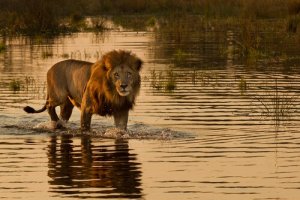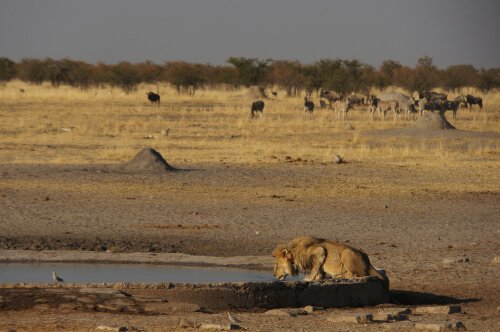The Lions that Hunt in the Sea


Written and verified by the vet Eugenio Fernández Suárez
Felines are quite adaptable predators and yet few of us could imagine that there are lions that hunt in the sea. These lions inhabit the desert coast of Namibia and have a very peculiar diet.
Lions that hunt in the sea
A study published in The Namibian Journal of Environment revealed that at least two prides in this area feed on marine wildlife. Animal researchers believe that lions that hunt in the sea could even feed on crustaceans.
Mainly, according to witnesses, the lions dig in the sand in search of food. However, this diet isn’t officially documented yet, so it’s still too early to say if it’s true or not.
Specifically, the lions that hunt in the sea feast on flamingos, cormorants, and seals. These are prey that aren’t part of the typical diet of these big cats.
For the most part, lions and other wildlife have a difficult time surviving in extreme climates. In addition, in this area of Namibia humans hunt the African lion due to livestock conflicts.
Consequently, this species was forced to migrate to other areas with less natural resources.

It’s not the first time that witnesses observed these lions capturing and eating seals. Other sightings were made public in 2006. However, back then researchers dismissed the actions as opportunistic hunting because seals are not part of a lion’s usual diet.
Furthermore, it seems that lions that hunt in the sea are no longer that rare. They seem to have adapted to a different diet.
The plundering of seals is particularly striking for researchers. This behavior in open land predators was only witnessed in polar bears prior to this.
The lions of the desert
Moreover, take into account that there are other groups of lions in Namibia who also dwell in extreme environments in the north of the country. Far from the coast, the so-called desert lions still survive.
In the Namib Desert, there are also many lions who must face long periods without being able to drink water. In fact, much of their obtained liquid intake is from the blood and muscles of their prey.
Interestingly, many of the lions of Namibia are quite different from those in other parts of Africa. However, this still doesn’t make them a part of a distinct subspecies.
Desert lions are animals with thicker fur due to the harsh desert nights they must endure. Also, they’re thinner-looking than their relatives from other parts of Africa.

Some believe that, among the two prides of lions that hunt in the sea, there are still about 100 desert lions. The rest of Namibia’s lions inhabit the Etosha National Park.
In addition, the lions that rule Africa live in smaller prides. However, they have a greater hunting territory because they must roam around more to find food.
Interestingly, infanticide rarely happens within this group of lions, which is something that does happen often in the groups of lions of the savanna.
Namibia has one of the lowest populations in the world, and the lions also have to deal with the harshness of such extreme climates. Furthermore, a lack of resources leads to a decline in food supply. For this reason, they’re forced to prey on local livestock.
Because of this, humans use poison in these areas to try to get rid of them. But, of course, the poison reaches other species as well –species like the black rhino.
Conservation groups
Conservation groups are at work on this matter, trying to find a balance between the conflicting needs of the people and the wild animals. Furthermore, they have created a local management structure that has a real interest in managing and conserving wildlife for the benefit of the people.
However, the return of lions and all other forms of wildlife to this area should signify a return to a healthier state of the environment. Conditions where the full range of predators and prey will create a balance that includes every animal, and also humans.
It should be a healthier state for the people currently living there, and also for those who benefit from all the resources that a healthy environment has to offer.
For this reason, many wonder if the lions that live in the desert and hunt in the sea will disappear. What will happen to the lions of Namibia?
Felines are quite adaptable predators and yet few of us could imagine that there are lions that hunt in the sea. These lions inhabit the desert coast of Namibia and have a very peculiar diet.
Lions that hunt in the sea
A study published in The Namibian Journal of Environment revealed that at least two prides in this area feed on marine wildlife. Animal researchers believe that lions that hunt in the sea could even feed on crustaceans.
Mainly, according to witnesses, the lions dig in the sand in search of food. However, this diet isn’t officially documented yet, so it’s still too early to say if it’s true or not.
Specifically, the lions that hunt in the sea feast on flamingos, cormorants, and seals. These are prey that aren’t part of the typical diet of these big cats.
For the most part, lions and other wildlife have a difficult time surviving in extreme climates. In addition, in this area of Namibia humans hunt the African lion due to livestock conflicts.
Consequently, this species was forced to migrate to other areas with less natural resources.

It’s not the first time that witnesses observed these lions capturing and eating seals. Other sightings were made public in 2006. However, back then researchers dismissed the actions as opportunistic hunting because seals are not part of a lion’s usual diet.
Furthermore, it seems that lions that hunt in the sea are no longer that rare. They seem to have adapted to a different diet.
The plundering of seals is particularly striking for researchers. This behavior in open land predators was only witnessed in polar bears prior to this.
The lions of the desert
Moreover, take into account that there are other groups of lions in Namibia who also dwell in extreme environments in the north of the country. Far from the coast, the so-called desert lions still survive.
In the Namib Desert, there are also many lions who must face long periods without being able to drink water. In fact, much of their obtained liquid intake is from the blood and muscles of their prey.
Interestingly, many of the lions of Namibia are quite different from those in other parts of Africa. However, this still doesn’t make them a part of a distinct subspecies.
Desert lions are animals with thicker fur due to the harsh desert nights they must endure. Also, they’re thinner-looking than their relatives from other parts of Africa.

Some believe that, among the two prides of lions that hunt in the sea, there are still about 100 desert lions. The rest of Namibia’s lions inhabit the Etosha National Park.
In addition, the lions that rule Africa live in smaller prides. However, they have a greater hunting territory because they must roam around more to find food.
Interestingly, infanticide rarely happens within this group of lions, which is something that does happen often in the groups of lions of the savanna.
Namibia has one of the lowest populations in the world, and the lions also have to deal with the harshness of such extreme climates. Furthermore, a lack of resources leads to a decline in food supply. For this reason, they’re forced to prey on local livestock.
Because of this, humans use poison in these areas to try to get rid of them. But, of course, the poison reaches other species as well –species like the black rhino.
Conservation groups
Conservation groups are at work on this matter, trying to find a balance between the conflicting needs of the people and the wild animals. Furthermore, they have created a local management structure that has a real interest in managing and conserving wildlife for the benefit of the people.
However, the return of lions and all other forms of wildlife to this area should signify a return to a healthier state of the environment. Conditions where the full range of predators and prey will create a balance that includes every animal, and also humans.
It should be a healthier state for the people currently living there, and also for those who benefit from all the resources that a healthy environment has to offer.
For this reason, many wonder if the lions that live in the desert and hunt in the sea will disappear. What will happen to the lions of Namibia?
All cited sources were thoroughly reviewed by our team to ensure their quality, reliability, currency, and validity. The bibliography of this article was considered reliable and of academic or scientific accuracy.
Mecenero, S., Kirkman, S. P., & Roux, J. P. (2005). Seabirds in the diet of Cape fur seals Arctocephalus pusillus pusillus at three mainland breeding colonies in Namibia. African Journal of Marine Science, 27(2), 509-512.
This text is provided for informational purposes only and does not replace consultation with a professional. If in doubt, consult your specialist.








